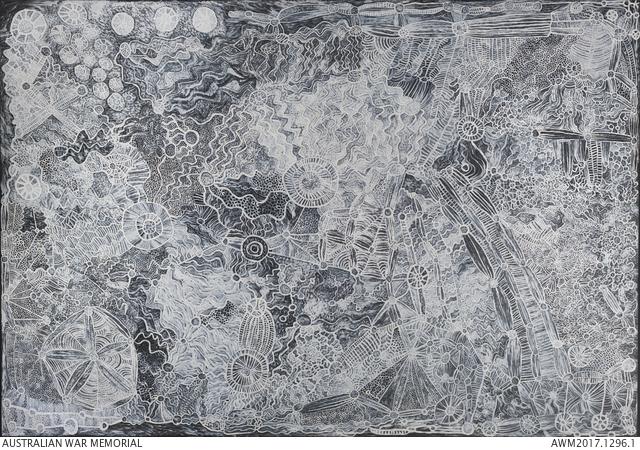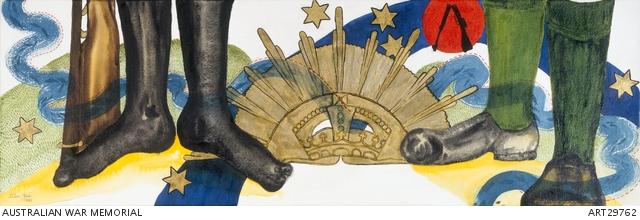Because of her, we can: Female Indigenous artists in the AWM Collection

Maralinga bomb
acrylic on canvas
AWM2016.581.1
This coming week the Memorial celebrates NAIDOC Week 2018 with the theme “Because of her, we can!” Under the theme, NAIDOC celebrates the invaluable contributions that Aboriginal and Torres Strait Islander women have made – and continue to make – to our communities, our families, to our rich history, and to our nation.
Among them have been trailblazers, politicians and activists who have fought and continue to fight for justice, equal rights to Country, and access to education. Perhaps best represented by the Memorial are those who have contributed to conserving culture and language through artistic practice.
In 2009, of the 35,000 artworks in the Memorial’s collection, only four were created by Indigenous female Aboriginal artists. Since then this number has grown to 19 through a strategic acquisitions program and the assistance of Tina Baum, Curator of Aboriginal and Torres Strait Islander Art at the National Gallery of Australia. Although it may seem a small number, these Aboriginal and Torres Strait Islander female artists demand equality and the preservation of Aboriginal law, culture, and history through their works. We are pleased to present the following highlights from the National Collection:
Queenie McKenzie

Horso Creek Killings
natural earth pigments on canvas
AWM2017.665.1
The work of Warmun artist Queenie McKenzie entered our collection in 2016 when the Memorial purchased her 1996 painting Horso Creek killings. Born around 1915 on Old Texas Downs, a cattle station east of Turkey Creek in the East Kimberley, McKenzie was a Gija elder and a respected leader in her community, as well as being a law woman, teacher and, artist. Her father was a gardiya (white-fella), and she evaded the attempts to remove her from her family as the Western Australian Government followed the assimilation policies that were in place at the time.
Through her artistic practice, McKenzie revealed intimate knowledge of her Country, explored through landscapes and dreamings. Like many Indigenous painters, she preserved this knowledge within her paintings for future generations. Her most notable paintings include colonial histories of the region, and she often painted scenes of early contact, including massacres, warfare, and indentured labour following the arrival of pastoralists in Gija lands in the late 1800s. McKenzie was particularly skilled at overlapping and combining historical and contemporary stories within a single painting.
McKenzie’s invaluable contribution to the arts was furthered by her involvement in the creation of Warmun Art Centre, formerly known as Turkey Creek, which opened in 1998. Most importantly, she played a strong role in mentoring young artists, including Shirley Purdie. McKenzie passed away in 1998 yet her legacy continues.
Betty Muffler

Ngangkari Ngura
acrylic on linen
AWM2017.1296.1
A recent addition to the Memorial’s collection is artist Betty Muffler’s work Ngangkari Ngura (Healing country). Muffler is a senior Pitjantjatjara artist and tradition healer from the north-east of South Australia in the Anangu Pitjantjatjara Yankunytjatjara (APY) Lands. In this work, Muffler depicts places of healing in her Country following the devastation caused by the weapons testing program at Maralinga during the 1950s and 1960s. Also in the collection is a depiction of Maralinga by female Pitjantjatjara artist Belle Davidson Karrika.
Muffler uses her work to document her cultural knowledge, and in doing so contributes direct personal experience to the history of Maralinga. Her work draws on her experiences of travelling through the APY Lands offering healing, and commemorates her movement in escaping the devastation of the bombs. Through her painting and her Ngangkari (healing) Muffler heals people, survivors, second generations, and her Country.
For Country, for nation

Aaaaaaa-tention!
watercolour with gold enamel over pencil on paper on linen
ART29762
A large part of our collection by female Aboriginal and Torres Strait Islander artists are contemporary responses to war, with artists documenting their family’s contributions to war and direct personal experiences. Torres Strait Islander artists Rosie Ware and Ellen Jose, for example, recall their fathers’ service in the 51st Battalion Far North Queensland Regiment and the 7th Australian Infantry Battalion, respectively. Their works provide commentary on events of global consequence but with design and symbology that is rich and reflective of their cultural heritage.
Along with Ware and Jose, Susan Wanji Wanji, Megan Cope, Myra Rory, Julie Dowling, Yhonnie Scarce, and Vicki West are examples of Indigenous female artists whose work is currently on tour in the For Country, for nation exhibition. First shown at the Memorial in 2016, this exhibition commemorates and explores Aboriginal and Torres Strait Islander experiences during wartime and peace.
NAIDOC events at AWM:
We are committed to collecting, preserving, and sharing the history of Indigenous Australians and to highlighting our unique collection of material relating to Aboriginal and Torres Strait Islanders.
Wednesday 11 July:
12pm
During NAIDOC Week, join a curator to view work by female Aboriginal and Torres Strait Islander artists, and discuss the significant contribution they make to our understanding of the Australian experience of war and its enduring impact.
Bookings are essential, and close Monday 9 July.
E: public.programs@awm.gov.au
P: (02) 6243 4473